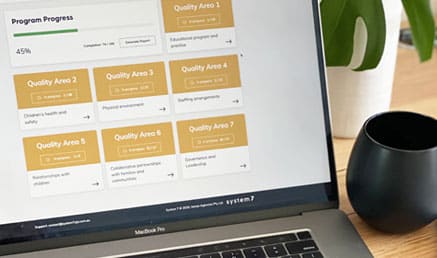
Welcome to our weekly quality improvement support series for 2022.
“It’s our polite nudge in the ribs to help you and your team stay organised and on task.”
This week’s subject is: Self-assessment and QIP Routine
Element 7.2.1: Continuous improvement
There is an effective self-assessment and quality improvement process in place.
- Is your service Quality Improvement Plan (QIP) a living document that communicates your services current strengths and areas of improvement?
- Does your QIP represent the perspectives of all key stakeholders i.e., staff, children, families and relevant community members?
The purpose of the QIP is to help providers self-assess their performance in delivering quality education and care, and to plan future improvements. The QIP also helps the regulatory authority with the assessment of the service. There is no requirement for the format of the QIP however it must meet the below requirements.
A QIP must:
- include an assessment of the programs and practices at the Service against the NQS and National Regulations
- identify areas of improvement
- include a statement about the Service’s philosophy
- be updated at least annually
- be available on request by the regulatory authority or parents of a child enrolled at the Service or looking to enrol at the Service
- be available at the principal office (Example: Family Day Care scheme)
- be prepared for a new service within 3 months of the service approval being granted and provided to the regulatory authority on request
The QIP cycle provides a visual guide, outlining the cycle for self-assessment and quality improvement planning:
Does your self-assessment and quality improvement planning incorporate the perspectives of all relevant stakeholders?
It’s imperative that your self-assessment and QIP include the perspectives of all stakeholders. This will ensure that all opinions and perspectives are considered and that your QIP is an accurate representation of the needs of your Service users.
Opportunities for this to occur should be a part of everyday practice. Creating systems and processes for engagement and feedback ensures it is ‘usual practice’ and embedded within the culture of the service.
Ensure you regularly collaborate with your team to develop new strategies for obtaining feedback from children and families about your service program and practices as part of your self-assessment and quality improvement planning cycle.
Resources:
Developing and reviewing your Quality Improvement Plan
We Hear You- The importance of self-assessment in a culture of continuous quality improvement
Programs like System7 take the headache out of completing and monitoring your self-assessment and QIP. It allows you the freedom to easily add self-assessment notes and tasks across all 7 quality areas, invite additional team members to assist and generate customised reports for both your self-assessment and QIP submissions. All supported by a detailed suggestions area to help guide your planning and continuous improvement.
Within System7 go to Quality Area 7/Modules 31, 32 and 33 to submit self-assessment notes and if required, open a QIP issue if you identify any areas of improvement. Not a member? Sign up for a 30-day free trial here.
Resources, NQS Element, Regulation and System7 links:
National Quality Standard – QA7 / 7.2.1: Continuous Improvement
National Regulations – 31, 55, 56
System7 Module – QA 7/ Modules 31, 32 and 33
If you have any questions send us a note via the Contact page here!




